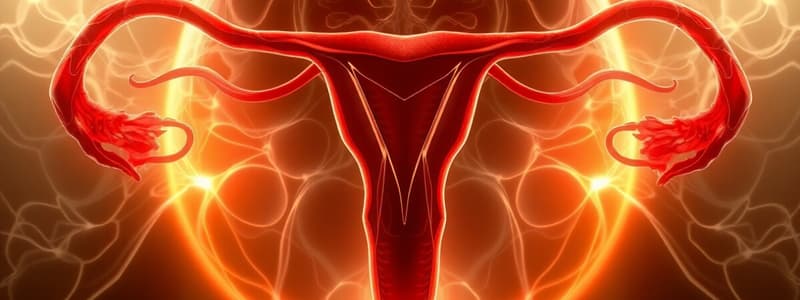Podcast
Questions and Answers
What is reproduction?
What is reproduction?
The process by which plants and animals produce more of their kind for the continued existence of the species.
What are the main functions of the female reproductive system?
What are the main functions of the female reproductive system?
Produce eggs, incubate and nourish a fertilized egg, produce female sex hormones.
What do ovaries produce?
What do ovaries produce?
Eggs (ova) and hormones that control the menstrual cycle and pregnancy.
What is the function of the fallopian tubes?
What is the function of the fallopian tubes?
What is the uterus commonly referred to as?
What is the uterus commonly referred to as?
What is the role of the cervix?
What is the role of the cervix?
What is the vagina also known as?
What is the vagina also known as?
What is the vulva?
What is the vulva?
What are the main functions of the male reproductive system?
What are the main functions of the male reproductive system?
What is the function of the penis?
What is the function of the penis?
What does the scrotum contain?
What does the scrotum contain?
What are testicles responsible for?
What are testicles responsible for?
What is the epididymis?
What is the epididymis?
What is the function of the ductus (vas) deferens?
What is the function of the ductus (vas) deferens?
Flashcards are hidden until you start studying
Study Notes
Reproductive System Overview
- Reproduction is essential for the survival of species, allowing plants and animals to produce offspring.
- The reproductive system consists of a collective group of organs and hormone networks that facilitate the creation of new life.
Functions of the Female Reproductive System
- Produces ova (eggs) necessary for reproduction.
- Incubates and nourishes fertilized eggs until they fully develop.
- Secretes female sex hormones that regulate the reproductive cycle.
Parts of the Female Reproductive System
-
Ovaries
- Two oval-shaped glands located on either side of the uterus.
- Responsible for hormone production and storage of eggs.
-
Fallopian Tubes
- Narrow tubes that guide fertilized eggs from the ovaries to the uterus.
-
Uterus
- Hollow, pear-shaped organ located in the lower abdomen.
- Known as the "womb," it holds the fetus during pregnancy and develops a rich lining each month to nourish a potential developing fetus.
-
Cervix
- The lower, narrow part of the uterus that leads to the vagina.
- Functions to allow menstrual blood to exit and permits sperm to enter.
-
Vagina
- The birth canal connecting the cervix to the exterior of the body.
-
Vulva
- The external portion of the female genitalia.
Functions of the Male Reproductive System
- Produces and transports sperm, essential for male reproduction.
- Discharges sperm into the female reproductive tract during sexual intercourse.
- Secretes male sex hormones that maintain male reproductive health.
Parts of the Male Reproductive System
-
Penis
- Comprised of the shaft and head, with a urethral opening for sperm delivery during intercourse.
-
Scrotum
- A sac-like structure that houses the testicles, blood vessels, and nerves; it regulates temperature for sperm production.
-
Testicles (Testes)
- Oval organs located in the scrotum, responsible for testosterone and sperm production.
-
Epididymis
- A tightly-coiled tube attached to each testicle where sperm matures and is stored.
-
Ductus (Vas) Deferens
- A muscular tube that carries mature sperm from the epididymis to the urethra for ejaculation.
Studying That Suits You
Use AI to generate personalized quizzes and flashcards to suit your learning preferences.




